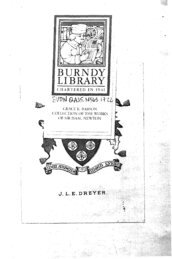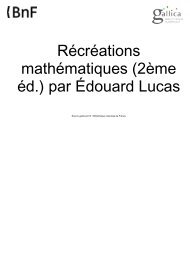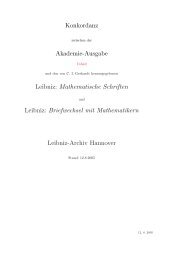The Second Book of Mathematical Puzzles and Diversions
The Second Book of Mathematical Puzzles and Diversions
The Second Book of Mathematical Puzzles and Diversions
You also want an ePaper? Increase the reach of your titles
YUMPU automatically turns print PDFs into web optimized ePapers that Google loves.
Iligitnl Roots 45<br />
Obtaining the digital root is simply the ancient process<br />
<strong>of</strong> "casting out 9's." Before the development <strong>of</strong> computing<br />
devices, the technique was widely used by accountants for<br />
checking their results. Some modern electronic computers,<br />
the International Business Machine NORC, for example, use<br />
the technique as one <strong>of</strong> their built-in methods <strong>of</strong> self-check-<br />
ing for accuracy. <strong>The</strong> method is based on the fact that if<br />
whole numbers are added, subtracted, multiplied or evenly<br />
divided, the answer will be congruent modulo 9 to the num-<br />
ber obtained by adding, subtracting, multiplying or dividing<br />
the digital roots <strong>of</strong> those same numbers.<br />
For example, to check quickly a sum involving large num-<br />
bers you obtain the digital roots <strong>of</strong> the numbers, add them,<br />
reduce the answer to a root, then see if it corresponds to the<br />
digital root <strong>of</strong> the answer you wish to test. If the roots fail<br />
to match, you know that there is an error somewhere. If<br />
they do match, there still may be an error, but the proba-<br />
bility is fairly high that the computation is correct.<br />
Let us see how all this applies to the telephone-number<br />
trick. Scrambling the digits <strong>of</strong> the number cannot change<br />
its digital root, so we have here a case in which a number<br />
with a certain digital root is subtracted from a larger num-<br />
ber with the same digital root. <strong>The</strong> result is certain to be a<br />
number evenly divisible by 9. To see why this is so, think<br />
<strong>of</strong> the larger number as consisting <strong>of</strong> a certain multiple <strong>of</strong><br />
9, to which is added a digital root (the remainder when the<br />
number is divided by nine). <strong>The</strong> smaller number consists<br />
<strong>of</strong> a smaller multiple <strong>of</strong> 9, to which is added the same digital<br />
root. When the smaller number is subtracted from the larger,<br />
the digital roots cancel out, leaving a multiple <strong>of</strong> 9.<br />
(A multiple <strong>of</strong> 9) + a digital root<br />
- (A multiple <strong>of</strong> 9) + the same digital root<br />
(A multiple o f9)+7

















